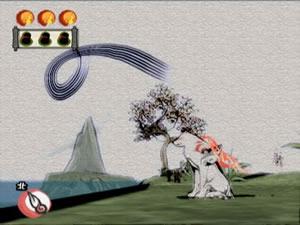God spelled backwards is wolf.
After churning out a big hit, what’s a developer to do? Play it safe with a sequel or go for broke with a new franchise? Sometimes, a little of both.
Clover Studio broke onto the scene with the amazing Viewtiful Joe and followed it up with a solid performance in Viewtiful Joe 2. Now, they’ve switched gears by creating a brand new world that managed to separate them from the loud, outrageous displays shown at this year’s E3. And the best part about it? They didn’t even need booth babes.
Okami is a cel-shaded action-adventure game based loosely on Japanese mythology. The story unfolds long ago in Ancient Japan, where a mythical monster known as the Orochi has returned to life and transformed the world into a desolate wasteland. Only the sun goddess, Amaterasu-o-mi-kami, can save the realm from eternal misery. Her avatar, and yours, is a mystical white wolf.
In gameplay terms, this means you’re quick, agile and supernaturally powerful. Your basic abilities include running around, charging with your head down, leaping and wall-jumping – things any respectable wolf should be able to do. But even the most dignified and able members of the pack can’t chop down barriers, fill rivers or lacerate enemies with their tails, and that’s where being a sun-goddess comes in handy.
Amaterasu’s tail is actually a “celestial brush” that can be used to alter reality in up to thirteen different ways. With the push of a button, the action pauses and the on-screen colors become dull shades of coffee-stain brown, as though the game itself had become an old piece of parchment. A cursor in the shape of a tail-tip can be manipulated with the L-stick, and pressing another button will touch the tip to the canvas, effectively letting you paint on the screen. We aren’t sure where the paint comes from, but we do know that by drawing certain symbols and strokes into the world, you can alter reality. For example, painting a circle around a dead tree brings it back to life, while drawing a vine can propel you across an otherwise impassable chasm. You will discover your powers through story-based objectives, and many of your obstacles will require you to figure out which stroke suits a situation.
But there’s more to Okami than painting happy little trees – its combat system also makes use of the celestial brush. As you adventure throughout the land, you’ll run into assortments of shadowy characters, at which point a dome will form over the battle area, trapping you and your opponents within its radius. You’ll want to weaken your enemies with simple dash attacks and maybe a Zangief-style pile driver. Once you’ve done enough damage, you drop into brush mode, paint some slashes through the bad guys, and watch as your strokes cut enemies in half.
In keeping with its thematic roots and odd gameplay mechanics, Okami simulates traditional Japanese Sumi-e painting with its cel-shaded, calligraphic visual style. The lines are bold and dark but the color palette is soft and slightly transparent, creating the appearance of a moving watercolor. And even though Okami works under a different aesthetic, it shares an abundance of decadent detail with the Viewtiful games. For example, bunches of flowers bloom
psychedelically
from each of Amaterasu’s footfalls. Okami was easily one of the most impressive looking games on display at E3, quite a feat considering the presence of next-gen titles.
It’s easy to discuss a game’s features as separate entities, treating graphics as though they had nothing to do with plot, because we aren’t used to such unified visions as Okami. Here, the visual style matches the folkloric concept, which is translated into a brand new play mechanic. Look for this puppy to put the good in god sometime in 2006.







